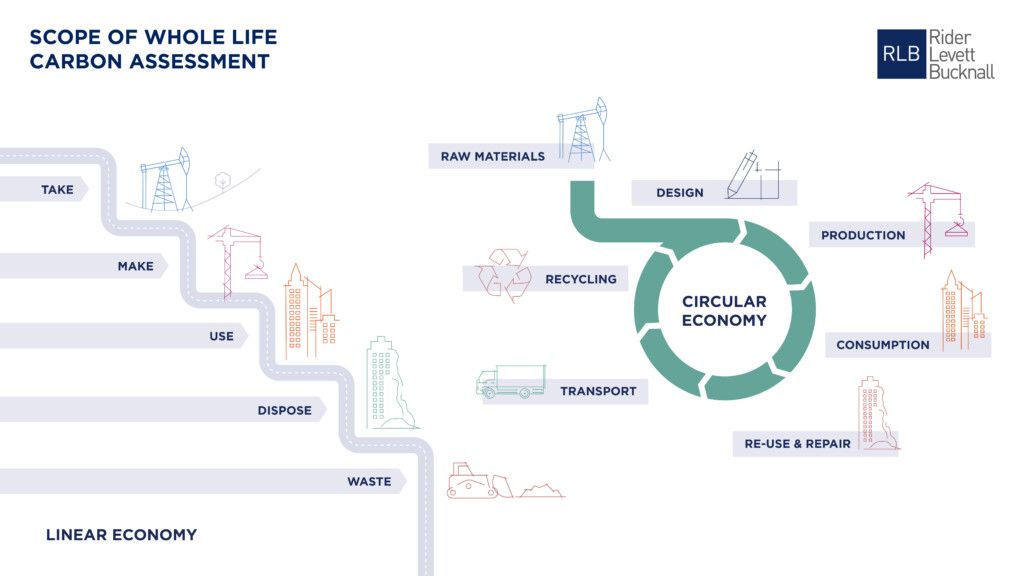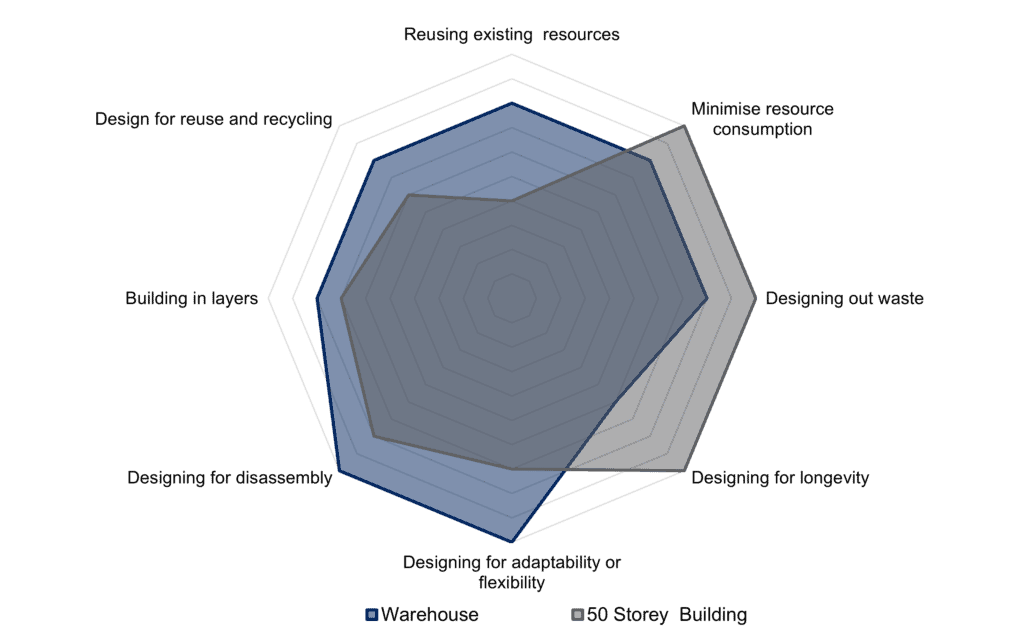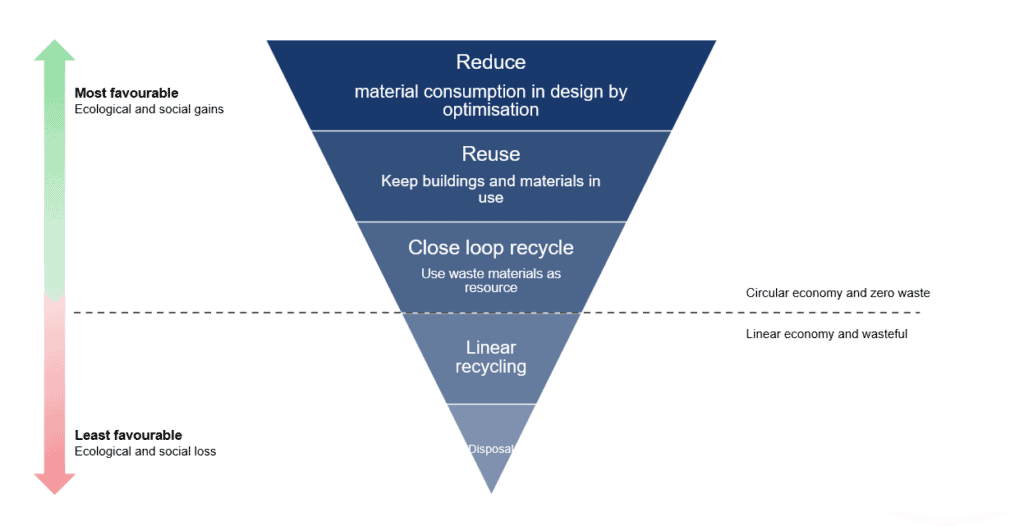In today’s construction industry, clients are navigating a complex landscape of rising costs, regulatory changes, and increasing demands for sustainability.
The traditional linear model of construction, where resources are extracted, used, and disposed of, is quickly becoming outdated. To meet the challenges of this evolving environment, a shift toward the circular economy is not just a choice—it’s a necessity.
What is the Circular Economy in Construction?
The circular economy is a transformative approach that prioritises keeping resources in use for as long as possible, minimising waste, and reducing the environmental impact of construction projects. By shifting from the linear “take, make, dispose” model to a regenerative one, the construction sector can significantly contribute to net-zero carbon goals while delivering value for clients.

Why the Circular Economy is Crucial
Adopting circular principles is essential not only for meeting sustainability targets but also for addressing the growing pressures faced by the construction industry. These pressures include:
1. Political and Regulatory Pressures:
Governments worldwide are implementing stricter environmental regulations to combat climate change. In the UK, policies such as carbon taxes, mandatory waste reduction targets, and commitments to net-zero emissions are forcing the construction industry to rethink its processes. For example, the Greater London Authority (GLA) now requires circular economy assessments alongside Whole Life Carbon Assessments (WLCA) for major development applications, a requirement soon to expand nationwide.
While WLCAs are useful for measuring carbon emissions, they often fail to offer actionable steps toward reduction. Circular economy assessments go further by identifying opportunities for reuse, recycling, and material efficiency, providing practical solutions for carbon reduction.
2. Economic Instability:
Volatile raw material prices, high inflation, and disrupted supply chains are placing significant financial strain on construction projects. Essential materials like steel and concrete have seen unpredictable price fluctuations, making it difficult to manage costs effectively.
3. Environmental Impact and Resource Scarcity:
Construction waste accounts for over 50% of the UK’s waste, while embodied carbon from materials such as concrete and steel contributes 14% of the country’s total emissions (UKGBC, 2019). With resources becoming scarcer, the industry must rethink how it sources, uses, and disposes of materials.
4. Social and Market Demand for Sustainability:
Investors, developers, and the public increasingly expect sustainable practices. Those who fail to adapt risk alienating key stakeholders and damaging their reputations in a market that increasingly values environmental responsibility.
Circular Economy Principles in Construction
To address these challenges, the circular economy offers a clear framework for sustainable construction. Key principles include:
1. Political and Regulatory Pressures:
Governments worldwide are implementing stricter environmental regulations to combat climate change. In the UK, policies such as carbon taxes, mandatory waste reduction targets, and commitments to net-zero emissions are forcing the construction industry to rethink its processes. For example, the Greater London Authority (GLA) now requires circular economy assessments alongside Whole Life Carbon Assessments (WLCA) for major development applications, a requirement soon to expand nationwide.
While WLCAs are useful for measuring carbon emissions, they often fail to offer actionable steps toward reduction. Circular economy assessments go further by identifying opportunities for reuse, recycling, and material efficiency, providing practical solutions for carbon reduction.
2. Economic Instability:
Volatile raw material prices, high inflation, and disrupted supply chains are placing significant financial strain on construction projects. Essential materials like steel and concrete have seen unpredictable price fluctuations, making it difficult to manage costs effectively.
3. Environmental Impact and Resource Scarcity:
Construction waste accounts for over 50% of the UK’s waste, while embodied carbon from materials such as concrete and steel contributes 14% of the country’s total emissions (UKGBC, 2019). With resources becoming scarcer, the industry must rethink how it sources, uses, and disposes of materials.
4. Social and Market Demand for Sustainability:
Investors, developers, and the public increasingly expect sustainable practices. Those who fail to adapt risk alienating key stakeholders and damaging their reputations in a market that increasingly values environmental responsibility.
Circular Economy Principles in Construction
To address these challenges, the circular economy offers a clear framework for sustainable construction. Key principles include:
- Design for Disassembly and Reuse:
Buildings are designed with modular components that can be dismantled and reused, reducing waste and extending the lifespan of materials. - Waste Reduction and Recycling:
By choosing materials that can be recycled or upcycled, construction projects reduce their environmental footprint and lower on-site waste. - Lifecycle Assessment and Resource Efficiency:
Through comprehensive whole-life carbon assessments, clients can identify resource-efficient materials and construction practices, optimizing sustainability from design to demolition. - Energy Efficiency and Renewable Resources:
Circular construction emphasises energy-efficient systems and renewable materials, reducing a building’s carbon footprint over its entire lifecycle. - Digital Tools for Precision:
Technologies like Building Information Modelling (BIM) allow for precise material tracking, waste reduction, and efficient project planning, embedding circular principles from the design phase.

Client Benefits of Circular Economy Adoption
Clients who embrace the circular economy in their construction projects can expect both immediate and long-term benefits:
- Cost Savings:
While there may be an upfront investment in sustainable materials, circular economy practices reduce lifecycle costs. Reusing materials reduces procurement and disposal expenses, while energy-efficient designs lower operational costs. - Regulatory Compliance:
By integrating circular economy principles early in the project, clients can stay ahead of increasingly stringent environmental regulations, avoiding potential fines and project delays. - Resilience Against Supply Chain Disruptions:
Circular practices that reuse materials and source locally reduce dependence on volatile global supply chains, offering greater stability in project planning and execution. - Sector-Specific Flexibility:
Circular economy principles can be tailored to meet the unique needs of different sectors. For instance:- Retail: Modular, adaptable designs cater to the fast-paced nature of the retail industry.
- Housing: Circular designs promote sustainable, affordable housing solutions.
- Offices: Adaptable office spaces reduce the need for future renovations, accommodating changes in work culture.
- Healthcare: Energy-efficient designs and durable materials reduce maintenance costs in high-energy healthcare facilities.
Overcoming Barriers to Circular Economy Adoption
Despite the clear benefits, several barriers may hinder the widespread adoption of circular practices in construction:
- Cost Concerns:
Although sustainable materials and processes may have higher initial costs, these are offset by long-term savings. A phased approach allows clients to gradually integrate circular principles, minimising financial strain. - Timeline Pressures:
Designing for disassembly and sourcing recycled materials can extend project timelines. Early integration of circular principles and the use of digital tools like BIM can streamline these processes. - Sector-Specific Challenges:
Different industries face unique challenges in adopting circular economy practices. Tailored solutions are essential to ensure that circular principles are practical and beneficial for each sector.

Immediate Client Impact
The adoption of circular economy practices delivers immediate value to clients by improving relationships with stakeholders, ensuring regulatory compliance, and enhancing operational efficiency. The shift toward circularity also provides a significant competitive advantage in a market where sustainability is increasingly a key decision-making factor.

In Conclusion
The shift towards a circular economy is not just about reducing waste and emissions; it’s about reimagining the entire lifecycle of construction materials, creating a system where resources are used more efficiently and sustainably. By doing so the construction industry can not only mitigate its environmental impact but also play a crucial role in safeguarding the planet for future generations.
FURTHER INFORMATION:



